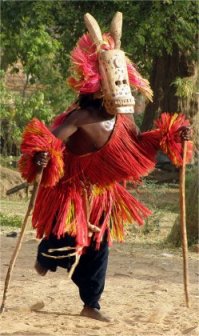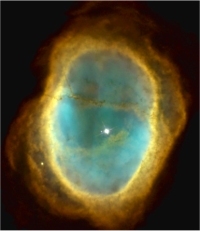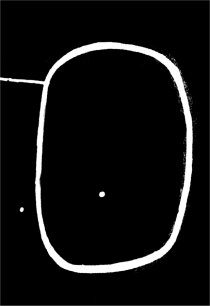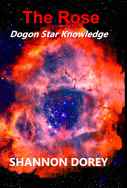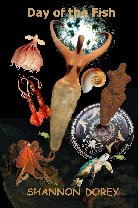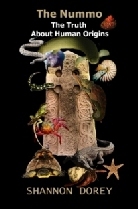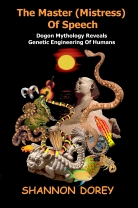The Nummo Appear at Saint-Sulpice in the Sculptures of Jean-Baptiste Pigalle
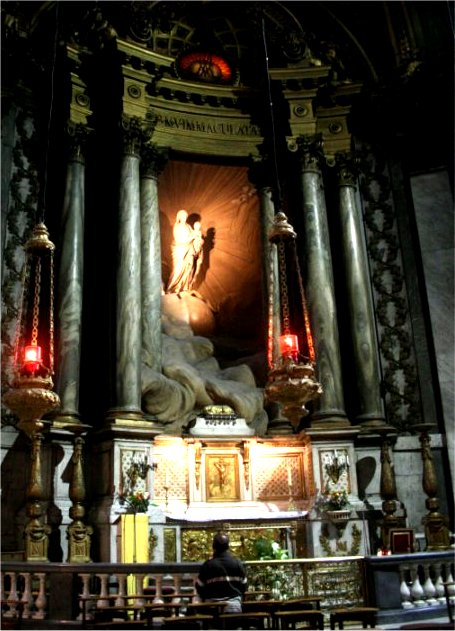 Altar of Mary by Jean-Baptiste Pigalle at Saint-Sulpice By Robert Hill |
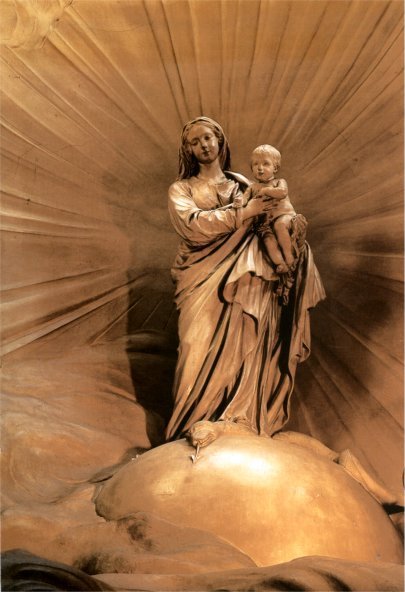 Close-up of Mary, the Serpent and the Sun by Robert Hill |
This is the altar of the Virgin Mary found inside Saint- Sulpice in Paris created by the French sculptor Jean-Baptiste Pigalle (26 January 1714 - 20 August 1785). The significance of this altar is that it displays the symbolism of the Dogon/pagan religion. A close-up of this sculpture of the Virgin Mary shows a serpent, which was how the Dogon elder Ogotemmêli referred to the alien Nummo. Because they were self-fertilizing hermaphrodites and could perform genetic engineering, the Nummo were associated with virgin goddesses. Besides being identified with the divine feminine, they were symbolized by the Sun, the rays of which appear behind Mary and the serpent.
The Sun that symbolizes the Nummo in the Dogon religion was associated with the red giant Sun that created the Universe. In the Dogon/pagan religion, a red giant Sun was considered a pregnant Sun. This is because when a red giant star explodes as a supernova it gives birth to new stars, suns and planets. Mary is clearly being associated with the Nummo in this sculpture. Notice the rose in the top middle of the altar with the M for Mary. A red Rose symbolized a red giant star in the pagan religion in Europe. There are also roses in the centre of the Roman pillars and symbols of DNA along each side, which the Dogon and others who practised this religion, understood as being associated with the creation of life.
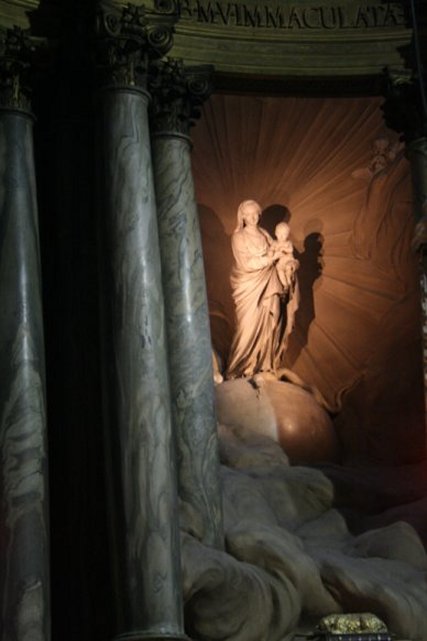 The Gas and Dust Being Emitted From the Sun by R. Hill |
The gas and dust being emitted from the Sun on the left of the sculpture, shown more clearly in this image, is being associated with the death of the red giant star. The gas and dust is what forms nebulae, which are considered stellar nurseries. It is in nebulae where new stars and planets form in the Universe.
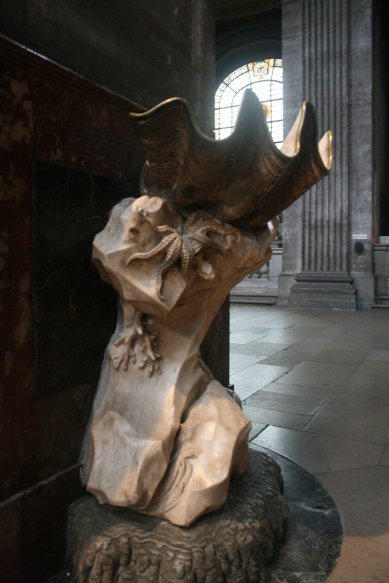 Holy Water Font with Octopus and Sea Images ©R.Hill |
Besides the sculpture of the altar of the Virgin Mary in Saint-Sulpice, Jean-Baptiste Pigalle also created this sculpture of the holy water font resting on a marble pedestal. Notice the octopus on the top left and the shell on top. In, The Nummo, I refer to the fact that the Nummo had characteristics that relate to cephalopods.
Cephalopods that exist today include the nautilus, the squid, the octopus, and the cuttlefish. Just like the Nummo, who were invertebrates, cephalopods lack backbones. With the exception of the nautilus, they also have special skin cells called chromatophores that allow them to change color for purposes of camouflage. They can change colour in an instant -much faster than the vertebrate chameleon- and match their surroundings perfectly. This describes the shape shifting abilities of the Nummo.
Cephalopods also have a blue blood pigment. Instead of the bright red pigment (haemoglobin) that all the vertebrates use for carrying oxygen, cephalopods use blue haemocyanin. (Although the pigment by itself is bluish, their blood is not; it's fairly clear.)This association, however, could tell us how "blue blood" came to be identified with royalty. The significance of this is that haemocyanin contains copper rather than iron. The two most important elements identified with the Nummo were water and copper. The Dogon associated copper with the Sun and water with the source of all creation.Shannon Dorey, The Nummo p. 251-252
According to Robert Graves, an authority on Greek Mythology, the cuttle-fish, which is another cephalopod, appears prominently in Cretan works of art, including the standard weight from the Royal Treasury at Cnossus, and also on megalithic monuments at Carnac and elsewhere in Brittany. It has eight tentacles, as the sacred anemone of Pelion has eight petals, eight being the number of fertility in Mediterranean myth.Shannon Dorey, The Nummo p. 252
Images of cuttlefish and octopus appear on ancient Greek vases which I believe are religious symbols associated with the Dogon/pagan religion.
 Terra Cotta Stirrup vase with Octopus 1200-1100 BCEhttp://en.wikipedia.org/wiki/File:Stirrup_vase_Rhodes_Louvre_CA2906.jpg Stirrup vase with octopus from Rhodes. Terracotta, Late Helladic IIIC1 (1200-1100 BC). Wikimedia Commons, Capitan Bequest, 1905 source:Jastrow |
This is a terra cotta stirrup vase with octopus from Rhodes, Late Helladic IIIC1 (1200-1100 BCE.) Notice the round eyes. The concentric circles depicting the Octopus' eyes on this vase were also an important symbol associated with Smiths in ancient Greece. The importance of this is that the Nummo were known as "Heaven's Smiths". Graves describes the significance of Smith's in ancient Greece in this passage.
The Cyclops seems to have been a guild of Early Helladic bronze-smiths. Cyclops means "ring-eyed", and they are likely to have been tattooed with concentric rings on the forehead, in honour of the sun, the source of their furnace fires; the Thracians continued to tattoo themselves until Classical times. Concentric circles are part of the mystery of the smith-craft: in order to beat out bowls, helmets or ritual masks, the smith would guide himself with such circles, described by compass around the flat disk upon which he was working. The Cyclops were one-eyed also in the sense that smiths often shade one eye with a patch against flying sparks.Shannon Dorey, Day of the Fish p. 118
In the Dogon religion, the Smithy was a metaphor for a blackhole. Just like some modern astrophysicists, the Dogon believed that the Universe formed inside a blackhole.
Based on my research, I believe that the sculptor Jean-Baptiste Pigalle was a French Cathar practising his religion in secret for fear of persecution from the Catholic Church. The Cathars were so-called heretics, who were almost exterminated during the Albigensian Crusade of 1209, when the Church of Rome called for crusaders to attack Languedoc in the south of France.
According to Harold Bayley, the heresies of the Albigensians (Cathars) were thought to have been stamped out by the Papacy but in fact it was French refugees who introduced paper-making into England. At the time Bayley was writing his book (in the early 1900s), the makers of the paper used for the Bank of England's notes were descendants of the De Portal family of Provence, many of whose members were recorded as having been "amongst the most active of the leaders of the Albigeois [Albigensians]." The founder had fled to England after the Revocation of the edict of Nantes in 1685, which had exterminated most of the Huguenots, whom Pope Clement XI, had identified with the Albigensians. He died there in 1704. The headquarters of the Huguenots were Auvergne, Angoumois and the Southern Province of France where in Angoumois alone, they had owned six hundred paper mills. In Glasgow one of the first refugees from France also succeeded in establishing a paper-mill, which was the first in that part of Scotland.Shannon Dorey, Day of the Fish p. 244
As a way to hide their beliefs from the Inquisition, the Albigensians embedded symbolic marks into the paper they used for printing popular literature of the era. It was an ingenious way to hide their religion from the Inquisition. Bayley's book The Lost Language of Symbolism studies the symbols that the paper makers had inserted into paper in the form of watermarks. These watermarks existed secretly for several centuries, beginning in 1282, before disappearing from history.Shannon Dorey, Day of the Fish p. 243-245 Many of the same symbols appear in the Dogon religion and are examined in The Nummo, Day of the Fish and The Rose. My research indicates that the Cathars also embedded their religious symbols in Gothic Cathedrals.
The letter M, which appears above Mary in Saint-Sulpice, also appears in the Cathar watermarks in association with the Star of the Sea. According to Bayley,
"Among the titles of Queen Mary is Stella Maris, the Star of the Sea- an appellation for which it is difficult to discern any Biblical justification. 'Star of the Sea' was, however, one of the titles of Isis and other pagan goddesses, and one must assume that it was sanctioned by Christianity for the usual reason that the people obstinately refused to relinquish it. The Star of the Sea is represented in the accompanying Water-Mother emblems, Mary, Maria, Myrrha, Miriam, or Mara, the sparking light of the waters, the virgin daughter of Labismina, the Great Abyss."Shannon Dorey, The Nummo p. 252
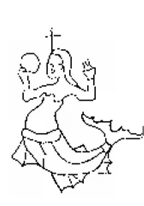 Mermaid Holding a MirrorShannon Dorey, The Nummo p. 119 |
The sea was associated by the Dogon with the Nummo. In some of the medieval watermarks of the Albigensians and others, the Star of the Sea was depicted as a mermaid holding a mirror. This is an image of a mermaid from the Albigensien Watermarks.
A mermaid holding a mirror also appears in the misericords, which are found carved on the underside of the hinged seats of choir-stalls in medieval churches and cathedrals. I believe these misericords was another way for these outlawed sects to preserve their beliefs under the nose of the Inquisition and the Roman Catholic Church.
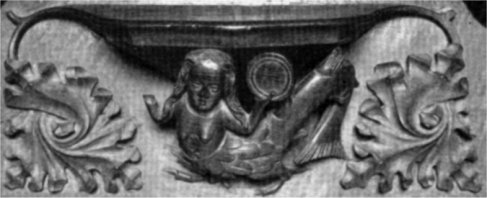 Mermaid at Carlisle Cathedral in England ©R. Hill |
The purpose of the mirror, according to Bayley was that it reflected sunlight. The Dogon associated a full moon as having religious significance for the same reason, because it reflected sunlight and the Nummo were symbolized by the Sun.Shannon Dorey, The Rose p. 252
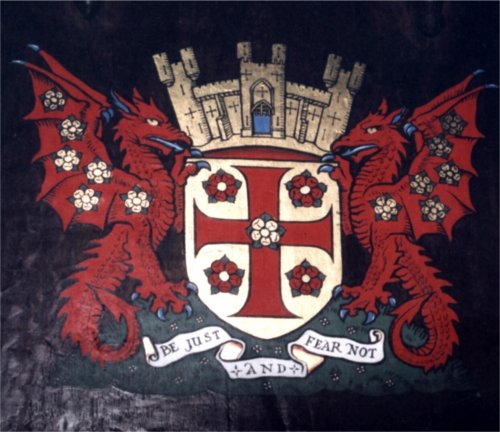 Red Dragons and Roses in Carlisle Coat of Arms ©R. Hill |
Besides depicting numerous relevant misericords in Carlisle Cathedral, the city of Carlisle is filled with symbolism relating to the Dogon/pagan religion. This is a picture of the Carlisle Coat of Arms, which was depicted on a 1610 map of the city engraved by John Speed. The dragon was a symbol of the Nummo in Celtic and Chinese mythology. Notice the red roses and the white rose in the centre. The white rose would have been a symbol of a white compact star or a dead Sun. The ancient Carlisle Corporation used a coat of arms from at least 1462. This was a gold shield bearing a red cross pattée between four red roses. A fifth rose, gold in colour was placed in the centre of the cross."Carlisle". Kelly's Directory of Cumberland. Historical Directories. 1910. p. 64. Retrieved 2009-06-23. https://en.wikipedia.org/wiki/County_Borough_of_Carlisle The cross pattée was referred to in my book, The Rose, because the same cross appears in the Dogon religion. It was also associated with the Knights Templar.
For more information about the Nummo and the Dogon religion refer to my books, which can be purchased at right.
